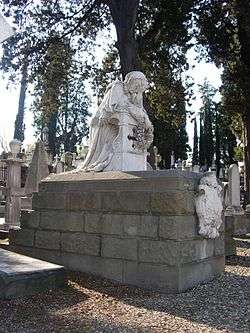English Cemetery, Florence


The English Cemetery in Florence, Italy is at Piazzale Donatello. Its names, 'Cimitero Inglese' and 'Cimitero Protestante' are somewhat misleading, as the cemetery holds bodies of Orthodox Christians as well as those of many Reformed Churches; but the majority of those buried here were of the Anglophone British and American communities of Florence.
History
Before 1827 non-Catholics and non-Jews who died in Florence were buried in the Old English Cemetery, Livorno. In 1827 the Swiss Evangelical Reformed Church acquired land outside the medieval wall and gate of Porta a' Pinti at Florence from Leopold II, Grand Duke of Tuscany for an international and ecumenical cemetery, Russian and Greek Orthodox burials joining the Protestant ones. Carlo Reishammer, a young architectural student, landscaped the cemetery, then Giuseppe Poggi shaped it as its present oval when Florence became capital of Italy. He surrounded it with studios for artists, including that of Michele Gordigiani (who painted the portraits of Elizabeth Barrett and Robert Browning, now in the National Portrait Gallery, London).
Burials
Among the many Swiss, Russians, Americans and British buried here, those of the English-speaking British and Americans are the majority as the Anglophone community in Florence in the nineteenth century was the largest.
Many famous people are buried in the graveyard: Elizabeth Barrett Browning (in a tomb designed by Frederic, Lord Leighton), Walter Savage Landor, Arthur Hugh Clough, Francesca Alexander, Fanny Trollope and her daughter-in-law Theodosia Trollope and three other family members, Isa Blagden, Thomas Southwood Smith, Hiram Powers, Joel Tanner Hart, Theodore Parker, Fanny, the wife of William Holman Hunt in a tomb he himself sculpted, Mary, the daughter of John Roddam Spencer Stanhope in a tomb he himself sculpted, Louise, sister to Henry Adams, whose dying he describes in his 'Chaos' chapter in The Education of Henry Adams, two children of the Greek painter George Mignaty, whom Robert had paint Casa Guidi as it was when Elizabeth Barrett Browning died there; Nadezhda De Santis, a black Nubian slave brought to Florence at fourteen from Jean-François Champollion's 1827 expedition to Egypt and Nubia, while the French Royalist exile Félicie de Fauveau sculpted two tombs here; Beatrice Shakespeare relative of William Shakespeare.
American historian, abolitionist and author Richard Hildreth, who died in Florence in 1865 after resigning his position as consul in Trieste, is also buried here near the grave of Transcendentalist minister and abolitionist Theodore Parker. These two tombs were toppled in the great storm of 19 September 2014 and are now restored.
Giampietro Vieusseux, Swiss, the founder of the Gabinetto Vieusseux (where John Ruskin, Fyodor Mikhailovich Dostoevsky, and Robert Browning were readers), is also buried here; and likewise the Swiss historian Jacques Augustin Galiffe, who with Jean Charles Léonard Simonde de Sismondi pioneered genealogical, archival research. Emily Dickinson treasured a photograph of Elizabeth Barrett Browning's tomb and wrote 'The soul selects her own society' about it, using lines also from Elizabeth Barrett Browning's Aurora Leigh; and Browning wrote a sonnet on Hiram Powers' sculpture The Greek Slave, which had been at the center of the Crystal Palace Exhibition, London, in 1851. Isa Blagden and Theodosia Garrett Trollope, part East Indian, part Jewish, were models for Miriam in Nathaniel Hawthorne's The Marble Faun, while George Mignaty's wife was the model for the head of Hiram Powers' Greek Slave. The cemetery is also the partial subject of Arnold Boecklin's Isle of the Dead, from its burial of his seven-month daughter, Maria Anna. In turn, the composer Sergei Rachmaninoff made use of Boecklin's painting for his Op. 29, The Isle of the Dead. Thus this cemetery forms a compendious memorial of western creativity, from America to Russia, from Scandinavia to Nubia, during Italy's 19th-century Risorgimento.
Inscriptions
The tomb inscriptions are in Hebrew, Greek, Cyrillic, fraktura and Roman scripts, and in many languages - Hebrew, Russian, French, German, Danish, Romansh, English, and include passages of the Bible in vernacular translations (inscribed at a time when only a Latin translation was accessible to Roman Catholics).
Closure and re-opening
The Cemetery had to be closed in 1877, when the law forbade burials of bodies within city limits.
Research has been carried out on the burial records in Britain, Russia and Italy, these being published in the virtual guidebook, http://www.florin.ms/WhiteSilence.html. The librarian of the cemetery seeks books written by and about those buried there; an appeal seeks tocontinue restoring the 'English' Cemetery in Florence after many years of neglect and abandonment to its former beauty, recorded in Victorian era guidebooks and early sepia photographs, particularly those taken by Hiram Powers' son, Longworth Powers, now in the Gabinetto Vieusseux.
The Scorpioni, a small group of elderly English ladies who lived in Florence in the 1930s and 1940s, used to frequent the cemetery.
The Comune of Florence has now allowed the Swiss Church, which owns the cemetery, to reopen it for burials, but only of cremated remains, not bodies.
See also
External links
| Wikimedia Commons has media related to English Cemetery, Florence. |
Coordinates: 43°46′39.09″N 11°16′05.39″E / 43.7775250°N 11.2681639°E